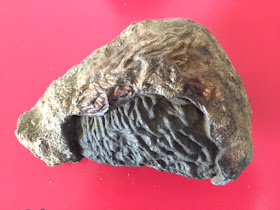These eight white flint tools are all from my find site. The site produces every kind of flint tool, adze, awls, scrapers, axes, knifes, burin's and bill hooks, with the exception of arrow heads. I usually post the most figurative examples, but these show less iconography than my usual prehistoric lithic implement posts.
The two photos below are from the same flint scraper.
Above, an ape like face profile can be seen looking right, and also a horse head profile also faces right.
Above the reverse side has a subtle human like face profile facing left.
The next four pictures show an adze, but it also makes a good awl and blade tool
Above, a familiar looking face profile can be seen on the right, looking left, probably that of a hominid.
Above, notice the re-touch along the bottom edge, making some nice serrations.
Above, three more prehistoric blade tools each one also carries likely figurative content.
The next three pictures are of a serrated knife, it shows signs of hafting.
The next two pictures also show a prehistoric serrated blade tool, this could also be used as an awl.
These two pictures show an axe like tool, although its a little small for chopping trees. flake removal scars suggest an attempt at creating iconography but as for the figurative depictions, I am unsure.






























